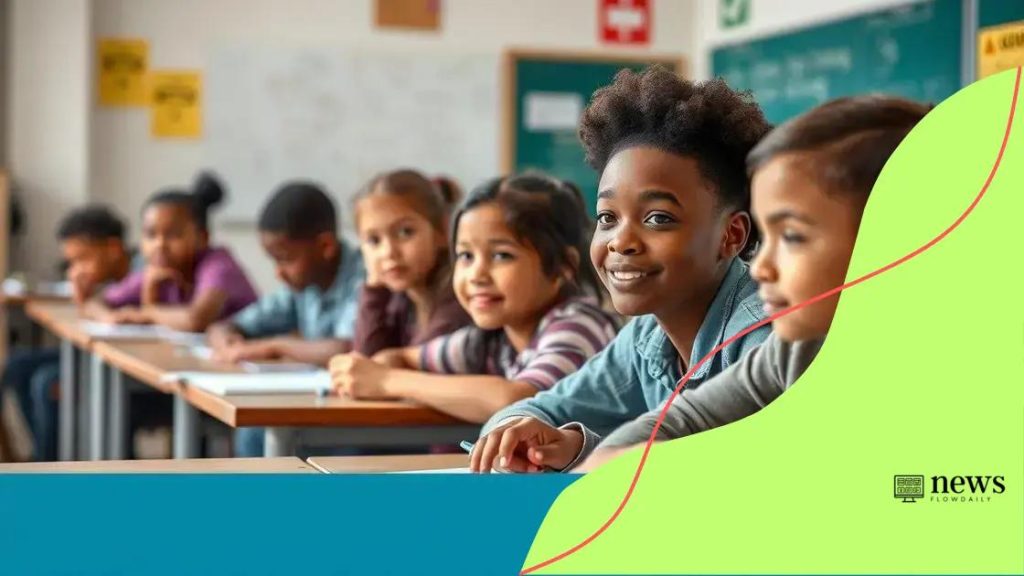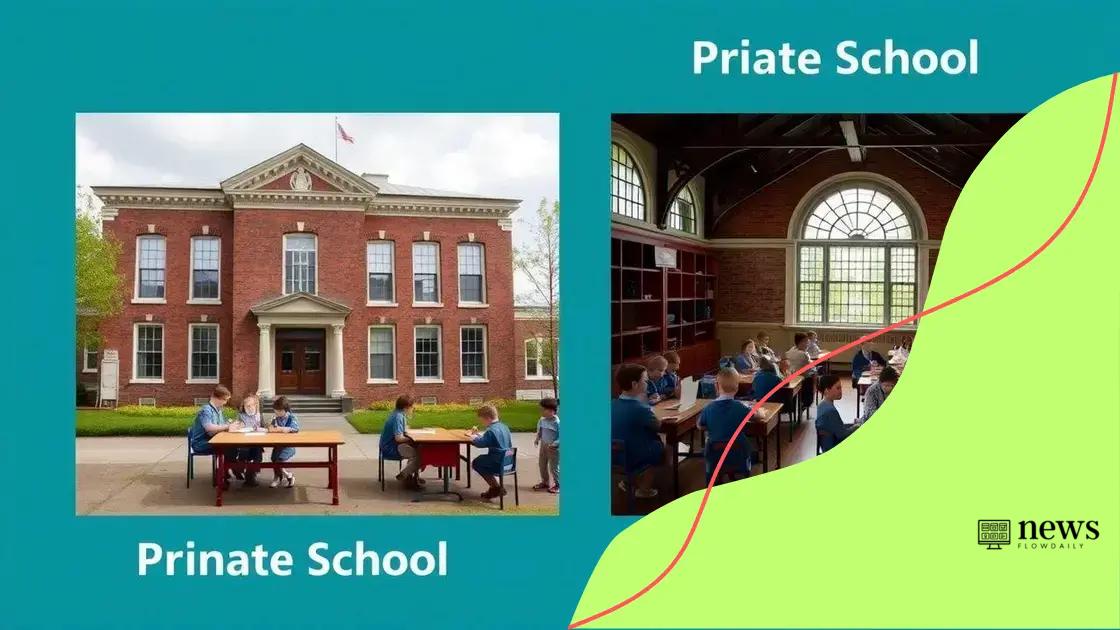Ongoing debates over funding disparities between public and private schools

Ongoing debates over funding disparities between public and private schools highlight significant differences in resource allocation, which directly affect educational quality and access for students in varying socioeconomic backgrounds.
Ongoing debates over funding disparities between public and private schools raise important questions about equity and access in education. Have you ever wondered how these differences affect students’ experiences and opportunities?
Understanding funding disparities in education
Understanding funding disparities in education is crucial to uncovering how resources are allocated between different types of schools. Many people question why public schools and private schools often operate under such different financial conditions.
These disparities can heavily influence educational outcomes. To illustrate, studies show that private schools typically have more funding available per student compared to their public counterparts. This difference leads to varying levels of access to educational materials and extracurricular activities.
The Role of Government Funding
Government funding plays a significant role in how schools operate. Public schools are funded mainly through local, state, and federal taxes, while private schools rely on tuition fees and private donations. This means that areas with higher property taxes usually see better funded public schools.
- Local property taxes majorly fund public schools.
- Private schools often set their tuition rates based on market demand.
- Funding inequities can lead to disparate educational opportunities.
- State funding formulas vary greatly, contributing to disparities.
In contrast, private schools can often be more selective in admissions, allowing them to choose students who are more likely to succeed. This selection process can create a perception that they are better performing, although it often comes down to resource availability rather than educational quality alone.
Impact on Student Outcomes
The impact of these funding differences stretches beyond just classroom resources. Research has shown that students in well-funded public schools typically have access to advanced courses, technology, and support services that can significantly affect their academic performance.
- Access to technology enhances learning experiences.
- Advanced courses prepare students for higher education.
- Support services can help struggling students succeed.
- Quality facilities contribute to a better learning environment.
By addressing these funding disparities, we can begin to level the playing field for all students, ensuring equitable opportunities regardless of the type of school they attend. It is important to foster discussions around this topic, aiming to bring about necessary reforms.
The impact of private school funding
The impact of private school funding is significant and touches various aspects of education. When we look at how these schools are financed, we can see clear differences compared to public schools.
Private schools often have access to larger financial resources, primarily through tuition and donations. These funds directly influence the quality of education provided to students. As a result, many private schools can afford smaller class sizes, which allows for more individualized attention.
Benefits of Increased Funding
Increased funding in private schools leads to several advantages that enhance the learning environment:
- More diverse and advanced programs for students.
- State-of-the-art technology available in classrooms.
- Greater extracurricular opportunities, including sports and arts.
- Professional development for teachers to improve instructional quality.
These benefits suggest that students in private schools may have better educational experiences due to the enhanced resources available to them. Additionally, private institutions can often implement innovative teaching methods and curricula that are less constrained by governmental regulations.
Comparison with Public Schools
On the other hand, the funding disparities between private and public schools can lead to ethical questions regarding educational equity. Public schools typically operate under stringent budget limitations reliant on local taxes.
This can result in overcrowded classrooms and fewer resources, which can hinder student achievement. For example, public schools may not have the funds to hire enough qualified teachers or maintain essential facilities. These limitations contrast sharply with private schools that enjoy more financial freedom.
This gap in educational quality raises concerns about the long-term consequences for students who attend underfunded public schools. The differences in outcomes can affect college readiness and future career opportunities for these students.
Public vs. private schools: A historical perspective

Public vs. private schools have had a long and complex history in education. Understanding their historical backgrounds helps us see how funding disparities evolved over time.
The establishment of public schools in the United States dates back to the early 19th century. Public schools were created to provide free education for all children, regardless of their background. This meant that everyone had access to basic education funded by local taxes.
Development of Private Schools
In contrast, private schools began appearing around the same time but were primarily focused on serving families who could afford to pay for education. These schools often offered specialized curricula and a smaller student-to-teacher ratio, attracting those seeking a different educational experience.
- Private schools often began as religious institutions.
- They catered to families wanting specific values taught alongside academics.
- Over time, many private schools became more competitive, offering advanced courses.
- Tuition and donations became essential for their funding.
As public schools grew, they faced the challenge of balancing quality education with funding limitations. Public schools aimed to provide a comprehensive education but struggled with overcrowding and inadequate resources.
The Growth of Educational Choice
In the late 20th century, the concept of educational choice emerged, allowing parents to choose between public and private schools. This movement gained momentum as people started questioning the effectiveness of public education. Private schools began showing higher student achievement, which attracted more families.
This shift created a perception that private schools were inherently better, but it also widened the gap in resources between the two types of schools. Critics argue that this system favors those with financial means, while public schools are left to serve every child without the same level of funding.
Current policies and their effects on schools
Current policies related to education have a profound impact on schools, shaping how resources are allocated and how educational quality is measured. These policies can vary greatly between public and private institutions, influencing everything from funding to curriculum.
Recently, many states have implemented reforms aimed at addressing funding disparities. Such policies include initiatives like voucher programs, which allow families to use public funding for private school tuition. This approach aims to give parents more choices but also raises concerns about diverting essential funds from public schools.
Impact on Public Schools
Public schools are often affected most by funding policies. When state budgets prioritize private school funding, public schools may face significant challenges. Overcrowding becomes an issue, and essential programs can be cut due to lack of resources.
- Increased class sizes limit individual attention for students.
- Less funding for essential materials and technology.
- Extracurricular activities may be reduced or eliminated.
- Higher turnover rates for teachers due to job dissatisfaction.
This dynamic creates a cycle where public schools struggle to meet educational standards, further widening the gap in educational quality.
Effects on Private Schools
On the other hand, policies that favor private schools often improve their ability to compete academically. With increased funding from vouchers, private schools can enhance their facilities and programs.
Many private schools take advantage of these funds to:
- Expand access to advanced placement courses and specialized programs.
- Enhance facilities with modern technology and resources.
- Attract qualified teachers with better salaries.
The consequence is that while private schools flourish under these policies, public schools often find themselves struggling to keep pace.
Voices from the community: Perspectives on educational funding
Voices from the community play a vital role in shaping the conversation about educational funding. Hearing directly from parents, teachers, and students can highlight the real effects of funding disparities, especially between public and private schools.
Community members often express their concerns regarding limited resources in public schools. Many parents feel that their children’s education is compromised due to inadequate funding. Schools in lower-income areas may struggle to provide basic supplies, advanced courses, and extracurricular activities.
Parental Perspectives
Parents’ opinions greatly influence education funding decisions. They emphasize the need for equal opportunities for all students, regardless of their background. Here are some common concerns:
- Large class sizes hinder personalized instruction.
- Lack of support staff affects student well-being.
- Underfunded schools cannot compete with private institutions.
- Extracurricular activities are often cut due to budget constraints.
This highlights the expectations that parents have regarding educational equity and the resources necessary for their children to succeed.
Teachers’ Insights
Teachers also share their experiences concerning funding gaps. Many report that they frequently spend their own money on classroom supplies. This situation affects their ability to provide a high-quality education. Teachers express the following:
- Inadequate resources limit their teaching effectiveness.
- Professional development opportunities are essential but often unavailable.
- Access to technology directly impacts student learning outcomes.
By listening to teachers, communities can better understand the need for equitable funding policies that support quality education for everyone.
Student Voices
Students themselves are increasingly vocal about their experiences in underfunded schools. They often advocate for change, asking for better facilities, more diverse course offerings, and equitable opportunities to thrive. Student perspectives can reveal:
- Awareness of disparities between their school and higher-funded counterparts.
- Desire for improved access to extracurricular activities and programs.
- Understanding that educational quality affects their future.
When communities unite around these voices, they can advocate for necessary changes in educational funding policies, ensuring that every student receives the quality education they deserve.
FAQ – Common Questions about Funding Disparities in Education
What are funding disparities between public and private schools?
Funding disparities refer to the differences in financial resources available to public and private schools, impacting the quality of education provided.
How do community voices influence educational funding policies?
Community voices, including parents, teachers, and students, provide valuable insights that can shape educational policies and advocate for equitable funding.
What role do vouchers play in school funding?
Vouchers allow families to use public funds for private school tuition, aiming to increase educational choice but sometimes diverting resources from public schools.
Why is it important to address funding disparities?
Addressing funding disparities is crucial to ensure that all students have equal access to quality education and the resources they need to succeed.





